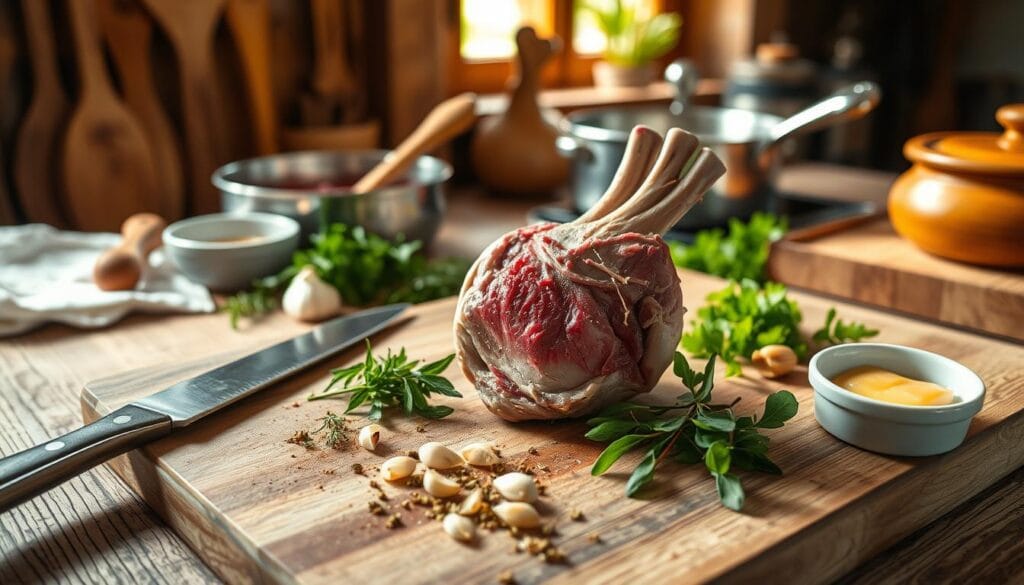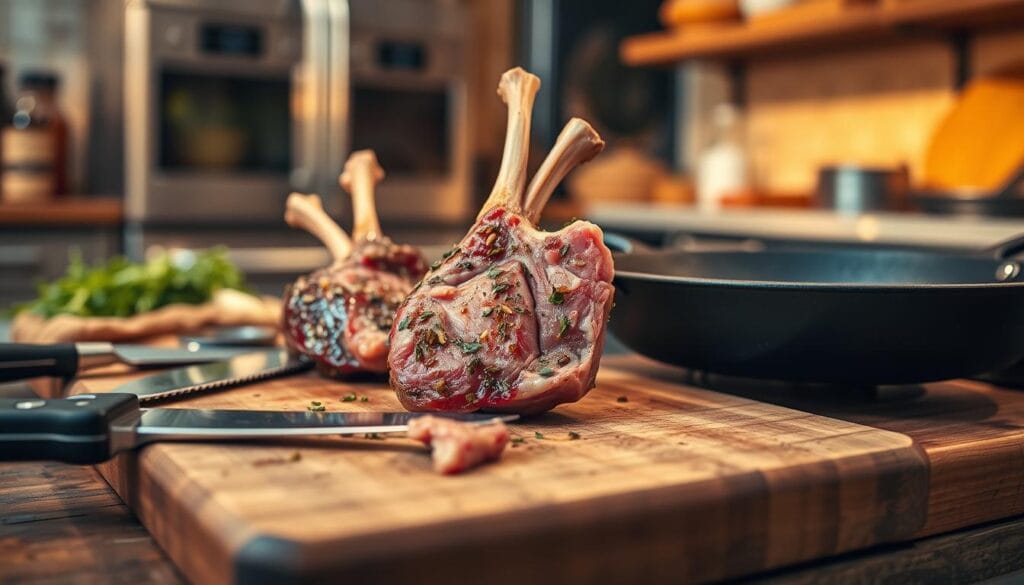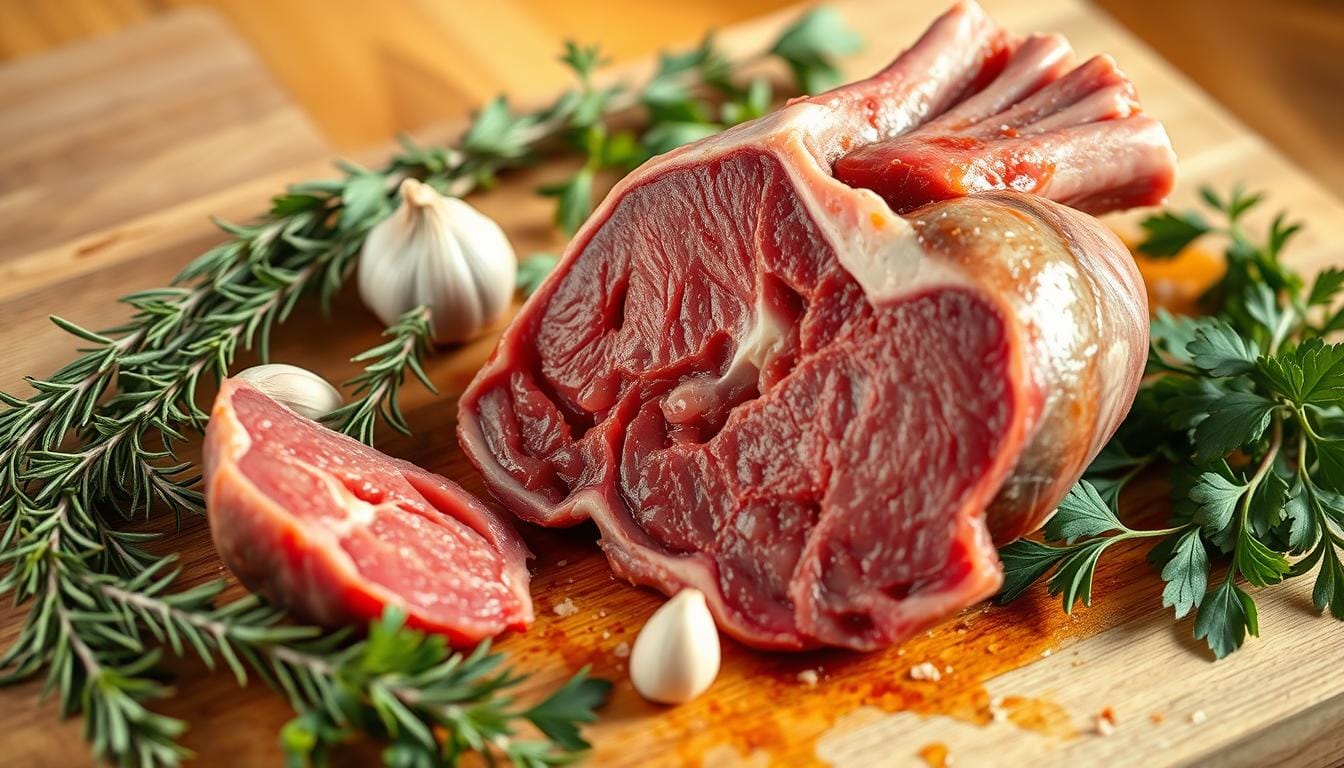Exploring offal cooking is a culinary adventure that challenges our meal expectations. My first try with a lamb heart recipe changed how I see organ meat dishes. It showed me a tender and nutritious ingredient that connects us to old cooking traditions.
Lamb heart is more than just meat—it’s a nutritional powerhouse that adds flavor and sustainability to your kitchen. Whether you love cooking or want to try new protein sources, this ingredient offers a unique dining experience. It goes beyond what we usually cook.
Table of Contents
Understanding Lamb Heart: A Nutritious Delicacy
Exploring ethnic cuisine often means trying new things. Lamb heart is a great example of this. It’s a part of nose-to-tail cooking that offers a unique taste.
Lamb heart is a top choice for those looking for healthy protein. It’s full of nutrients that make it great for your health.
Health Benefits and Nutritional Value
Lamb heart is packed with amazing health benefits:
- High protein content: Approximately 20-25 grams per 100 grams
- Rich in essential B-vitamins
- Excellent source of iron (6 mg per 100 grams)
- Vitamin B12 content around 2.3 micrograms per 100 grams
Taste Profile and Texture
Lamb heart has a distinctive culinary experience. It’s dense but becomes tender when cooked right. Its flavor is a bit gamey, perfect for those who love trying new things.
Sustainable and Economical Choice
“Nose-to-tail cooking isn’t just a trend—it’s a responsible approach to consuming meat.” – Chef Michael Paterniti
Choosing lamb heart is more than just a healthy choice. It’s also good for the planet and your wallet. Organ meats are affordable and help reduce food waste.
By adding lamb heart to your meals, you’re doing more than just trying something new. You’re joining a tradition that values every part of the animal and boosts nutrition.
Essential Preparation Techniques
Preparing lamb offal needs careful attention and specific techniques. These steps turn this unique ingredient into a tasty dish. Knowing the right methods helps you make heart recipes that show off global flavors and the meat’s full potential.
Cleaning and Trimming Methods
When working with lamb heart, cleaning is key. Here’s how to get your meat ready:
- Rinse the heart under cold running water
- Remove any visible blood vessels and excess fat
- Pat dry with paper towels to ensure proper seasoning adherence
- Trim away tough membranes and connective tissue
Marination Tips and Seasonings
Marinating lamb heart boosts its flavor. Pro tip: Always marinate for at least 1 hour to allow seasonings to penetrate the meat. Try these flavor mixes:
- Mediterranean blend: Olive oil, lemon juice, garlic, rosemary
- Middle Eastern inspired: Cumin, coriander, paprika, yogurt
- Herbaceous mix: Thyme, oregano, red wine vinegar
“The secret to delicious lamb heart is in the preparation and seasoning.” – Professional Chef
Pre-cooking Preparations
Before cooking, take these steps for the best results:
- Allow meat to reach room temperature (about 30 minutes)
- Dry the surface completely to achieve perfect searing
- Season generously just before cooking
- Use a sharp knife to slice against the grain for tenderness
By following these steps, you’ll make lamb heart into a delicious and impressive dish. It will show off its unique taste and global culinary potential.
Classic Lamb Heart Recipe

Starting a lamb heart recipe is an exciting journey. It turns this nutrient-rich organ meat into a tasty dish. You’ll begin by preparing it carefully and seasoning it well to bring out its rich flavors.
Ingredients You’ll Need
- 2-3 cleaned lamb hearts
- 3 tablespoons olive oil
- 4 garlic cloves, minced
- 2 sprigs fresh rosemary
- 2 sprigs fresh thyme
- Juice of 1 lemon
- 2 tablespoons balsamic vinegar
- Salt and black pepper to taste
Preparation Steps
- Clean lamb hearts thoroughly, removing connective tissues
- Slice hearts into 1/2-inch thick medallions
- Create marinade by mixing olive oil, garlic, herbs, lemon juice, and balsamic vinegar
- Marinate lamb heart pieces for 30 minutes to 24 hours
Understanding the lamb heart’s unique texture is key. Marinating tenderizes the meat and adds deep flavors. This turns the organ meat into a gourmet dish.
“Cooking lamb heart is about respecting the ingredient and unlocking its potential through thoughtful preparation.” – Professional Chef
| Cooking Method | Temperature | Cooking Time |
|---|---|---|
| Grilling | Medium-High Heat | 3-4 minutes per side |
| Pan-Searing | High Heat | 2-3 minutes per side |
| Slow Cooking | Low Heat | 6-8 hours |
Your journey with lamb heart promises a nutritious and tasty adventure. It’s packed with about 30 grams of protein and B-vitamins. This recipe is both delicious and good for you.
Cooking Methods and Techniques

Exploring different cooking methods can turn lamb heart into a tasty dish. It shows off flavors from around the world. Learning the right techniques helps you cook offal perfectly, making it tender and delicious
Each cooking method changes the texture and taste of lamb heart. They all have their own benefits for cooking this protein-rich meat.
Pan-Frying Method
Pan-frying makes the outside crispy and the inside tender. Here’s how to do it:
- Slice the heart into thin, even pieces
- Season with salt and pepper
- Heat a cast-iron skillet with olive oil
- Sear for 2-3 minutes per side
- Aim for a golden-brown crust
Slow-Cooking Approach
Slow-cooking makes the meat tender. It’s great for rich flavors in organ meat dishes.
- Place lamb heart in a slow cooker
- Add herbs and liquid (broth or wine)
- Cook on low heat for 6-8 hours
- Ensure internal temperature reaches 145°F
Grilling Instructions
Grilling adds a smoky flavor to lamb heart. It’s important to prepare it right:
- Marinate for at least 1 hour
- Use a marinade with olive oil, garlic, and herbs
- Grill for 5-7 minutes per side
- Let rest for 5 minutes before serving
Pro tip: Always slice lamb heart against the grain to ensure maximum tenderness.
Every cooking method highlights different aspects of lamb heart. This lets you try various flavors and techniques in offal cooking.
Perfect Pairings and Side Dishes
Exploring ethnic cuisine and culinary exploration means finding the perfect side dishes. The right choices can make your lamb heart meal unforgettable. It’s all about creating a dish that pleases your senses.
- Roasted root vegetables
- Creamy mashed potatoes
- Fresh green salad with herb vinaigrette
- Quinoa with Mediterranean spices
- Grilled seasonal vegetables
Most side dishes take 20-30 minutes to prepare. This makes them easy to add to your lamb heart meal.
| Side Dish | Preparation Time | Flavor Profile |
|---|---|---|
| Roasted Parsnips | 30 minutes | Sweet, earthy |
| Herb Quinoa | 20 minutes | Light, aromatic |
| Mint Sauce Salad | 15 minutes | Fresh, zesty |
Wine lovers can pair lamb heart with a full-bodied red wine. Syrah or Grenache work well. They match the meat’s bold flavor for a classy dining experience.
“A great side dish can elevate a simple meal into a thrilling culinary experience.”
Tips for Achieving the Best Results
Exploring heart recipes needs precision and care, especially with lamb heart. Mastering cooking techniques can turn this nutrient-rich ingredient into a tasty meal. It will surprise and delight you.
Temperature Control Guidelines
Cooking lamb heart requires careful temperature control for safety and flavor. Here are some key guidelines:
- Always cook lamb heart to an internal temperature of 145°F
- Use a meat thermometer for accurate readings
- Avoid overcooking to prevent tough, dry meat
Resting and Serving Suggestions
After cooking, let your lamb heart rest for 5-10 minutes. This step helps juices redistribute, making the dish tender and flavorful. For a great look, slice the heart against the grain and serve on a warm plate.
“Patience in cooking transforms good ingredients into extraordinary meals.”
Storage and Reheating
Proper storage keeps your heart recipes enjoyable longer:
- Refrigerate cooked lamb heart within 2 hours of cooking
- Keep in an airtight container for up to 3 days.
- Freeze for extended preservation up to 2 months
When reheating, use low heat to keep moisture and prevent toughness. A gentle warm-up in a covered skillet or oven keeps your meal delicious.
Conclusion
Your journey with lamb heart is more than a recipe. It’s a way to learn about sustainable and healthy cooking. The recipe you learned shows how to make tasty meals from often ignored parts of the animal.
Learning to cook lamb heart has made you a better chef. You’ve discovered new ways to cook, like marinating and controlling temperature. These skills will help you cook other unique dishes too.
We encourage you to share your experiences with lamb heart. Try new seasonings and keep exploring. Every time you use less common meat, you help the environment and find new flavors.
Are you ready for more adventurous cooking? Your journey is just starting. The world of nose-to-tail cooking is full of exciting possibilities for you to discover.
FAQ
What does lamb heart taste like?
Lamb heart tastes rich and slightly gamey, more intense than regular lamb. It’s dense and meaty, like lean beef. When cooked right, it’s tender and flavorful, perfect for those who love bold tastes.
Is lamb heart nutritionally beneficial?
Yes, it’s packed with nutrients! It has high-quality protein, iron, vitamin B12, and minerals. It’s also a great source of CoQ10, which is good for the heart. Plus, it has more nutrients per ounce than muscle meats.
How do I clean lamb heart before cooking?
Cleaning it is key. Remove fat, connective tissue, and veins. Slice it open, rinse under cold water, and dry with paper towels. Trim tough membranes for a tender dish.
What are the best ways to cook lamb heart?
It’s versatile and can be cooked many ways. Pan-searing, grilling, or slow-cooking work well. Just don’t overcook it to keep it tender. Quick, high-heat methods are best.
Is lamb heart considered sustainable eating?
Yes, it’s a great example of nose-to-tail cooking. Using organ meats reduces waste and supports sustainable food. It’s good for the planet and follows sustainable practices.
What should I serve with lamb heart?
It goes well with robust sides like roasted root veggies, creamy polenta, or fresh herb salads. Try red wines like Syrah or Grenache for a good match. Mediterranean or Middle Eastern dishes are also great choices.
How long can I store cooked lamb heart?
Store it in an airtight container in the fridge for 3-4 days. Reheat it gently to keep it tender. Slow reheating with a bit of moisture is best.
Is lamb heart safe to eat?
Yes, if bought from a trusted source and cooked to 145°F, it’s safe. Ensure it’s fresh, properly handled, and cooked correctly to prevent foodborne illnesses.


1 thought on “Delicious Lamb Heart Recipe: A Unique and Flavorful Dish”